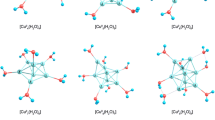Abstract
Technological applications of metallic clusters impose very strict requirements for particle size, shape, structure and defect density. Such geometrical characteristics of nanoparticles are mainly determined by the process of their growth. This work represents the basic mechanisms of cluster formation from the gas phase that has been studied on the example of copper. The process of Cu nanoclusters synthesis has been studied by the molecular-dynamics method based on tight-binding potentials. It has been shown that depending on the size and temperature of the initial nanoclusters the process of nanoparticle formation can pass through different basic scenarios. The general conditions of different types of particles formation have been defined and clear dependence of the cluster shape from collision temperature of initial conglomerates has been shown. The simulation results demonstrate a very good agreement with the available experimental data. Thus, it has been shown that depending on the specific application of the synthesized particles or in electronics, where particles of a small size with a spherical shape are required, or in catalytic reactions, where the main factor of effectiveness is the maximum surface area with the help of temperature of the system it is possible to get the realization of a certain frequency of this or that scenario of the shape formation of nanocrystalline particles.







Similar content being viewed by others
References
Weber A P, Davoodi P, Seipenbusch M and Kasper G 2003 J. Nanopart. Res. 5 293
Castelletto S and Boretti A 2013 Nanosci. Nanotechnol. Lett. 5 36
Fissan H, Kennedy M K, Krinke T J and Kruis F E 2003 J. Nanopart. Res. 5 299
Gangwar J, Kim J, Kumar A, Bhatnagar D, Senthil K, Tripathi S K, Yong K and Srivastava A K 2013 Nanosci. Nanotechnol. Lett. 5 67
Gafner S L, Gafner J J, Bardakhanov S P and Lysenko V I 2012 J. Comput. Theor. Nanosci. 9 102
Suzdalev I P 2006 Nanotechnology: physico-chemistry of nanoclusters, nanostructures and nanomaterial (Moscow: ComKniga) p 592 (in Russian)
Cleri F and Rosato V 1993 Phys. Rev. B 48 22
Gafner Yu Ya, Gafner S L and Entel P 2005 Phys. Met. Metallogr. 100 61
Gafner Yu Ya, Gafner S L, Meyer R, Redel L V and Entel P 2005 Phys. Solid State 47 1353
Darby S, Mortimer-Jones T V, Johnston R L and Roberts C 2002 J. Chem. Phys. 116 1536
Meyer R, Lewis L J, Prakash S and Entel P 2003 J. Phys. Rev. B 68 104303
Gafner S L, Redel L V, Ya Gafner Yu and Samsonov V M 2011 J. Nanopart. Res. 13 6419
Gafner Yu Ya, Gafner S L, Zamulin I S and Redel L V 2013 Nanosci. Nanotechnol. Lett. 5 1283
Pang T 2006 An introduction to computational physics (Cambridge : University Press) p 385
Gafner S L and Gafner Yu Ya 2008 J. Exp. Theor. Phys. 107 712
Erhart P et al 2004 Appl. Surf. Sci. 226 12
Luemmen N and Kraska T 2004 Nanotechnology 15 525
Smirnov B M 2010 Cluster processes in gases and plasmas (Weinheim : Wiley-VCH) p 433
Alayan R, Arnaud L, Broyer M, Cottancin E, Lermé J, Vialle J L and Pellarin M 2006 Phys. Rev. B 73 125444
Honeycutt J D and Anderson H C 1987 J. Chem. Phys. 91 4950
Krasnochtchekov P, Albe K, Ashkenazy Y and Averback R S 2005 J. Chem. Phys. 123 154314
Bardakhanov S P, Volodin V A, Efremov M D, Cherepkov V V, Fadeev S N, Korchagin A I, Marin D V, Golkovskiy M G, Tanashev Yu Yu, Lysenko V I, Nomoev A V, Buyantuev M D and Sangaa D 2008 Jpn. J. Appl. Phys. 47 7019
Acknowledgements
This study was performed within the framework of the State Task of the Ministry of Education and Science of the Russian Federation and supported in part by the Russian Foundation for Basic Research (project no. 13_02_98000_r_sibir’_a).
Author information
Authors and Affiliations
Corresponding author
Rights and permissions
About this article
Cite this article
CHEPKASOV, I.V., GAFNER, Y.Y., GAFNER, S.L. et al. The general mechanisms of Cu cluster formation in the processes of condensation from the gas phase. Bull Mater Sci 38, 701–706 (2015). https://doi.org/10.1007/s12034-015-0909-9
Received:
Revised:
Published:
Issue Date:
DOI: https://doi.org/10.1007/s12034-015-0909-9



